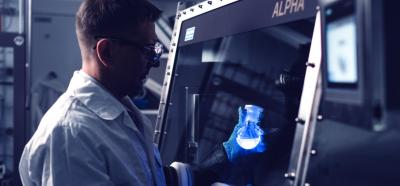Germany-based beeOLED announced that it has raised $14.4 million in its Series A funding round, co-led eCAPITAL and Innovation Industries. Other investors include KBC Focus Fund and the company's existing investors M Ventures (the corporate venture capital arm of Merck), HTGF, TGFS, and JBN-Invest.
beeOLED was established in 2020 with an aim to develop deep-blue OLED emitters. The company's material technology is based on intra-metallic emission, that has been used in other display technologies in the past but have not been usable in OLED displays yet. beeOLED said that it is the first to make intra-metallic molecules compatible with the vacuum processing technology used in high-volume OLED display manufacturing.
beeOLED's CEO, Dr. Jan Blochwitz-Nimoth has 20+ years experience in managing deep tech teams and companies, and is the founder and CTO of Novaled. Dr. Jan was kind enough to answer a few question we had regarding beeOLED, its technology and business.
Q: Hello Dr. Jan. Congratulations on this round. Can you tell us more regarding the intra-metallic emission technology? Should this be considered a new OLED emitter type/generation?
Yes, it’s a totally new group of emitter materials. Intra-metallic emission to generate blue requires divalent Europium (EU(II), this ion was used in plasma screens to generate deep blue). The beauty of intra-metallic emitters is that the light generation is all inside a single cation. Basically during the process of generating the photon no organic bonds are weakened.
Up to now, this particular cation could not be handled in OLED as it is not stable enough (it wants to be Eu(III) - but this is a red emitter). Here, we found a way to stabilize Eu(II) and make it ready to be vacuum coated. It shall be a plug-and-play solution for OLED manufacturers but as for all OLEDs an optimized stack will require specially chosen surrounding materials (emitter hosts with high triplet energy, etc.).
Q: Can you share any performance points, lifetime, efficiency ( I see 100% IQE), color point and emission width?
We share today that we achieved 100% internal photoluminescence efficiency (in deep blue, 455nm, measured in solution). We can vacuum evaporated our materials and they are air stable for handling. We can fine tune emission colour (e.g. between 450 and 465nm), we can tune their energetic properties (required for stack optimization). We achieve above 10% EQE at this colour point, but we believe >20% will be possible soon. We don’t share lifetime data yet. We are still early stage what full OLED optimization is concerned and are open to cooperate with host materials makers on this matter.
Q: When do you think your materials could reach the market?
We very likely still need around 3-4 years until mass manufacturing with our materials can be expected.
Q: Are you also working on red, green and yellow materials?
No, blue is the problem to solve, the other colours are good enough.
Q: Do you have any partners that are already testing these emitters?
As said before, emitters are only half of the equation and that the one we focus on. Yet, we do rely on good host materials and here we are open to cooperate with host materials makers on OLED optimization. Tests with/at customers are planned for 2024.
Thank you Dr. Jan, good luck and we're waiting for your next update!



